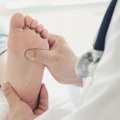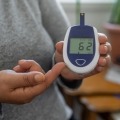Exercise Well with Your CGM – Recommendations, Glucose Trends, and Strategies
By Francine Kaufman
![]() By Dr. Francine Kaufman
By Dr. Francine Kaufman
Dr. Francine Kaufman breaks down what we need to know about avoiding hypoglycemia and hyperglycemia during and after exercise. She explains the recommendations and guidelines recently outlined in a position statement by global diabetes organizations to help people with type 1 diabetes exercise while using continuous glucose monitoring
What increases someone’s risk for hypoglycemia and hyperglycemia during and after exercise? Recently, a position statement on the use of continuous glucose monitoring (CGM) during exercise was published by some of the world’s leading diabetes organizations to discuss this question. The paper was filled with charts and recommendations for people with type 1 diabetes, including new ways to look at your CGM data to determine risk for swings in glucose levels as a result of exercise. My hope is to pull out the pearls and the practical tips that you can use to exercise with minimal unwanted high and low glucose levels.
Click to jump down:
The position statement was a joint effort of the European Association for the Study of Diabetes (EASD), the International Society for Pediatric and Adolescent Diabetes (ISPAD), the JDRF, and the American Diabetes Association (ADA). It was 20 pages long, with ten graphs or tables and 106 references. You can find the paper here. The 30 authors focused on how to use CGM data before, during, and after exercise to help prevent the all-too-often serious swings in glucose readings that can occur with activity. While this report focused on type 1 diabetes, it is likely applicable to people with type 2 diabetes who are on an intensive insulin regimen and use CGM.
One of the first items discussed in the paper was the accuracy of CGM during exercise. As many people know, there can be real differences between simultaneously measured glucose values when you compare blood glucose obtained by a fingerstick and interstitial glucose levels measured by all commercial CGM devices. These differences are in large part due to what we call “lag.” Changes in glucose levels in the blood are not seen as quickly in the subcutaneous fluid under the skin (called the interstitial fluid), so the interstitial fluid glucose level lags behind the blood glucose level. At rest, there is minimal lag of about five minutes; in situations when glucose changes rapidly, such as during exercise, lag time can increase up to 12-24 minutes (these are the very specific numbers given in the position statement).
Why does exercise increase the lag? In addition to inducing rapid changes in glucose, exercise also causes changes in local tissue metabolism, blood flow, and body temperature. This lag makes the main CGM accuracy measurement, called MARD (mean absolute relative difference between sensor glucose and a simultaneous blood reference glucose value), slightly higher – and the higher the MARD the less accurate the interstitial glucose reading.
What does this mean for you? You should trust your symptoms of high or low glucose and address them during exercise. You should look at not just the number on your CGM but also the arrows to see which way they are going. If the direction is down, you can consider treating with carbohydrate or stopping the physical activity for a while to decrease your risk of developing hypoglycemia.
Types and Duration of Exercise
The position statement discussed the effects of different types of exercise and how often one does them. Mild to moderate aerobic exercise – such as brisk walking, running, swimming, or cycling, also known as cardio or cardiovascular conditioning – typically decreases glucose levels. Intense aerobic or anaerobic interval exercise, usually done in short bursts with maximal effort (such as weightlifting or sprinting), stabilizes or increases glucose levels.
How often someone does aerobic exercise for 45 minutes or more helps to determine their risk for hypoglycemia resulting from exercise. The less you exercise, the greater your risk:
-
People who intensely exercise (more than two bouts of 45 minutes per week) are at low risk of hypoglycemia
-
Those who intensely exercise (one or two bouts of 45 minutes per week) are at moderate risk for hypoglycemia
-
People who don’t do 45-minute bouts of exercise (zero times per week) are at high risk for hypoglycemia
To lessen the risk of hypoglycemia, the paper recommended that different (and specific) starting glucose levels should be considered:
-
Those at high risk for hypoglycemia should start exercise at a glucose level as high as 161 mg/dL
-
Those with moderate risk should start exercise at 145 mg/dL
-
Those at low risk should start exercise at 126 mg/dL
-
People with hypoglycemia unawareness, preceding episodes of hypoglycemia, and those who are older age (over 65 years) are potentially at increased risk of hypoglycemia with exercise and should adjust starting glucose levels to the higher range of 161 mg/dL.
How to Use Time Below Range with Exercise
With the above as background, the position statement focused on how to maximize the use of CGM before, during, and after exercise. Time Below Range (TBR), or the percent of sensor glucose values below 70 mg/dL over the preceding three months, can be assessed on your CGM report. A TBR below 4% adds little risk, a TBR of 4-8% adds moderate risk, and a TBR above 8% adds high risk.
Another method to mitigate risk of hypoglycemia during exercise is to change the hypoglycemia alert setting to a higher value. Most hypoglycemia alerts are set at 70 mg/dL, but you can temporarily set the alert to 100 mg/dL. Remember, if there is a longer lag time for the interstitial glucose level to catch up to the blood glucose level (12-24 minutes), having a higher setting for the alarm will help compensate for that lag time. You could also consider using rate of change alarms so that rapid swings of your glucose level can be detected.
The position statement included a detailed description of what to do before, during, and after exercise to keep glucose levels stable for adults with type 1 diabetes. As per the position statement, the next sections do not apply to closed loop systems; if you are using closed loop, do not follow these recommendations.
Glucose Levels and Trend Arrows Before Exercise
Before exercise, people can administer insulin, take oral glucose, or delay the start of exercise depending on their pre-exercise glucose level and the direction of the CGM arrows.
-
Someone should consider taking a half dosage of correction insulin if their glucose level is great than 270 mg/dL and if arrows are level or increasing.
-
For glucose above the target range (above 180 mg/dL) – depending on the type, duration, and intensity of the planned exercise, and if arrows are increasing – a reduced correction dose can be considered, or exercise can just begin.
-
For lower starting glucose values, level or decreasing arrows, and depending on the planned exercise routine, variable doses of oral carbohydrate should be considered, along with delaying exercise until glucose values come up to an acceptable pre-exercise level.
-
At both extremes – glucose above 270 mg/dL with moderate or high ketone levels (ketones occur with insufficient insulin and can indicate impending illness or increased risk of diabetic ketoacidosis) and glucose below 70 mg/dL – exercise should be delayed until the glucose levels have stabilized, or the person should not exercise at all.
Glucose Levels and Trend Arrows During Exercise
A similar model was developed for the actions to take while in the midst of exercising.
-
The target glucose ranges during exercise are 90-180 mg/dL, and 126-180 mg/dL for prolonged aerobic exercise.
-
If glucose levels elevate during exercise (above 270 mg/dL), a reduced correction dose of insulin should be considered, particularly if arrows are level or increasing. If nausea or any other symptoms also experienced, ketones should be measured. If ketones are present, stop exercise.
-
For glucose levels that rise above 180 mg/dL, with level or increasing arrows, a reduced correction insulin dosage could be considered or exercise could just continue.
-
For glucose levels that are lower, exercise can just continue or variable doses of oral glucose can be ingested (depending on the planned exercise routine, arrows, and degree of risk for hypoglycemia).
-
The paper recommended that exercise be halted for glucose levels below 70 mg/dL.
Glucose Levels and Trend Arrows After Exercise
Post-exercise, the glucose target is 80-180 mg/dL. If you have a high risk for hypoglycemia, the target can be raised to 90 or 100-180 mg/dL. For 90 minutes after exercise, CGM glucose should be monitored regularly.
-
Oral carbohydrate ingestion is recommended for lower glucose values, and for level or decreasing arrows until glucose is stabilized.
-
To reduce the risk of late or nocturnal hypoglycemia, CGM low alerts can be raised to at least 80 mg/dL for the night, and added carbohydrate consumed at that level or below.
While the recommendations above were developed for adults, a similar set of before, during, and after exercise recommendations were written for children. The recommendations for children follow the same principles but use higher target glucose levels to trigger carbohydrate ingestion and stoppage of exercise. The paper also encouraged the use of the data share capability of the CGM for remote monitoring of children’s glucose levels. Sharing your CGM readings during and after exercise seems like a smart recommendation for adults, as well.
Adjusting insulin levels before and after exercise was also discussed in the position statement. Reducing mealtime bolus insulin prior to exercise by 25-50% should be considered, depending on the type and intensity of exercise. This bolus reduction means less insulin on board (IOB) during exercise to lower the risk of hypoglycemia.
You should also think about adjusting basal insulin dosages. For people on multiple daily injections of insulin (MDI), the prior night’s basal dosage could be reduced by 20%. For those using insulin pumps, consider decreasing basal rates by up to 50%, starting 60-90 minutes before and during activity, and decreasing basal insulin by 20% the night after exercise.
Before exercise – plan the type, intensity and duration of exercise, and the time of day in relation to your meals and bolus doses of insulin. Assess your insulin on board (IOB), determine your target glucose range for your risk of hypoglycemia, and watch your trend arrows
During exercise – keep in mind the safe glucose target of 126-180 mg/dL (or higher, if high risk of hypoglycemia). If the lower end of the target is reached (126 mg/dL), consider consuming carbohydrates, with the amount depending on the direction of the trend arrows. If you are concerned, also increase your low alarm to that 126 mg/dL level. If glucose levels elevate above 270 mg/dL, consider a 50% insulin correction.
After exercise – during the first 90 minutes after exercise, the target range is 80-180 mg/dL; carbohydrates should be ingested at the lower range of that target. Set CGM alarm at 80 mg/dL through the night.
Understanding how to use CGM to help manage exercise is critical to build safety into your activity routines. Hopefully, this will enhance the joy you experience with exercise and the health benefits you receive.
This article is part of a series on Time in Range.
The diaTribe Foundation, in concert with the Time in Range Coalition, is committed to helping people with diabetes and their caregivers understand Time in Range to maximize patients' health. Learn more about the Time in Range Coalition here.
About Francine
Dr. Francine Kaufman is the Chief Medical Officer of Senseonics, Inc. She is a Distinguished Professor Emerita of Pediatrics and Communications at the Keck School of Medicine and the Annenberg School of Communications at the University of Southern California.







